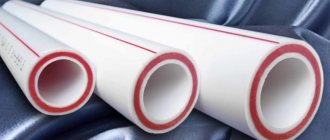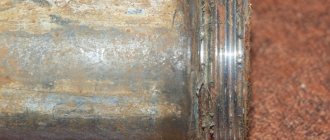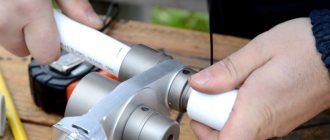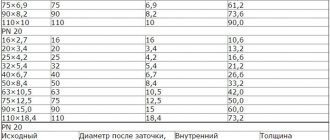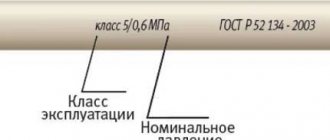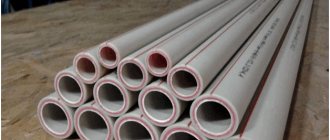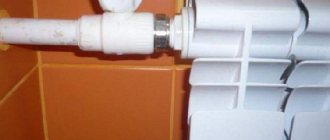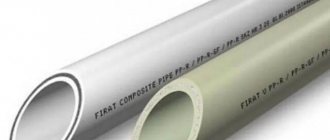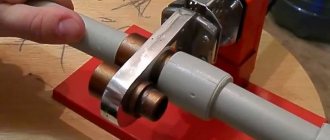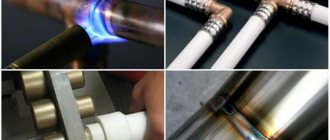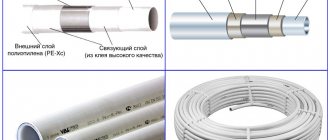Until recently, water supply and sewerage systems in Moscow and St. Petersburg were laid mainly using metal pipes. They were connected by welding, as well as using special connecting parts - fittings.
Fittings for metal pipes were made of stainless steel or cast iron. These products were distinguished by significant strength, however, they were susceptible to corrosion, and their price was not affordable. The popularity of plastic pipes is largely due to the ease and speed of their installation, which becomes even easier thanks to the use of plastic fittings. Polypropylene fittings are used when laying water supply systems when installing plumbing fixtures, etc.
The bulk of fittings for polypropylene pipes, which are sold today on the Russian market, are products of foreign manufacturers. Many of them have extensive experience in the production of this type of product, which is easy to use and high quality, and fully meets currently developed standards. Polypropylene fittings from manufacturers such as SAB, Blue Ocean can be used when laying hot and cold water supply systems in both residential and industrial buildings. They are also used in heating systems, as well as process pipelines. Polypropylene fittings have the same properties as PP pipes; their installation does not affect the quality of water and the strength of the pipeline as a whole.
There are several main types of fittings for polypropylene pipes: angles, plugs, valves, couplings, etc. All fittings are highly resistant to chemical influences, corrosion, and ensure complete tightness of the connections made using them. Each type of plastic pipe uses its own types of connecting elements. HDPE pipes are connected using polyethylene fittings. Fittings for HDPE pipes are intended for installation of HDPE pipelines used as water supply systems, sewerage systems, gas pipelines, etc.
Among the currently produced fittings for polyethylene pipes, several main types can be distinguished. To connect pipes of the same diameter, so-called straight fittings are used. If you need to connect pipes of different diameters, the use of reducing products is very convenient. Separately, it is worth noting compression fittings, the use of which does not require welding. A relatively new type of fittings for polyethylene pipes is electric welding.
Their design includes an electric heating element. Polyethylene fittings are produced in the same assortment as products made from other materials: elbows, couplings, plugs, tees, saddles, etc. Along with the advent of PVC pipes, fittings made from this material also appeared. The advantages of PVC are widely used in various areas of human activity - found They are also used in the production of fittings. The main advantage of PVC fittings is their resistance to the aggressive effects of many chemicals, including acids and alkalis.
They do not contain toxic substances and are not susceptible to ultraviolet radiation or thermal radiation. Due to their qualities, PVC fittings are used not only in everyday life when laying water supply and sewerage systems, but also when laying industrial pipelines. PVC fittings are easy to install and dismantle, have a convenient fastening system and are lightweight. Connection using such products allows you to achieve complete tightness of the pipeline. HDPE fittings are produced with different diameters, which correspond to all diameters of HDPE pipes made of polyethylene of any brand.
There are several types of HDPE fittings, namely: cast, compression, electrofusion (electric welded), welded. offers to buy fittings of any type, the price of which will undoubtedly suit you. Every day the number of pipes of various modifications on the market is increasing. Increasingly, builders prefer to use plastic pipes rather than steel and cast iron pipes. Polypropylene pipes are confidently replacing metal pipes. The quality and service life of the entire system depends on how strong and durable the pipe connection is.
Connection of polypropylene pipes
Polypropylene is a polymer that melts easily. It is quite flexible and plastic.
Therefore, not every type of connection is suitable for polypropylene pipes. If you cut a thread on a pipe, then such a connection will not provide reliability. Compression fittings are not used for polypropylene pipes.
The fact is that they strongly compress the pipe at the junction.
Water will certainly flow there. In some cases, a press connection using a rubber insert is used. However, such a connection is not very reliable. Any mechanical impact can damage it. If polypropylene pipes are heated, they will melt.
Therefore, diffusion welding can be used. Then the connection will be strong and monolithic. It turns out that welding is the most reliable type of connection of polypropylene pipes. But in domestic conditions, connecting pipes with fittings is often used. In this case, the pipes are connected joint to joint using manual polyfusion thermal welding. What is socket welding? This is a connection in which two adjacent surfaces are melted.
This is the outer and inner part of the fitting. It is very important that both pipes that are connected consist of the same type of plastic. Socket welding is considered more reliable than butt welding. It is worth noting that the fittings must also be made of the same material as the pipes.
Differences in fittings depending on the material and design used
There are more than 30 types of fittings based on form factor. But in addition to differences in purpose, elements are divided according to their suitability for a particular type of polypropylene pipe.
There are fittings consisting only of polypropylene, and those combined in the design using metal. What is their difference and purpose, we will consider below.
Full polypropylene fittings
Fittings made exclusively from polypropylene are more affordable because they consist of the same material as the pipe itself, and they are manufactured only by casting.
Polypropylene fitting.
An electric pipe soldering iron is used to connect different sections of pipe with fittings. It can be xiphoid or cylindrical. The working part contains places for installing couplings. The control is carried out by a thermostat. The two end parts of the polypropylene fitting are mounted on couplings corresponding to their diameter. The latter are coated with Teflon to prevent the plastic from sticking.
Soldering of polypropylene pipes.
The tool heats up to 260 degrees, which softens the polypropylene. After this, you need to remove the plastic parts from the soldering iron and carefully connect them together by inserting the pipe into the fitting. Due to strong heating, the materials are mixed and a new single crystal lattice is formed.
Soldered fitting in section.
The joint is similar in density and tightness to the pipe itself. The service life of the connection reaches 50 years.
The following technology is used for soldering polypropylene fittings to create:
- pneumatic lines;
- DHW systems;
- heat supply and heating circuits;
- HVS systems;
- technological communications in production.
The connection method is cheap and reliable. It can be covered with building materials after crimping and not controlled. With proper soldering, there are no leaks.
Almost all types of fittings are produced from pure polypropylene (adapters from one diameter to another, tees, angles, manifolds), so the entire system can be soldered exclusively with them.
The only drawback of such elements is the inability to disassemble the connection. If you need to organize an additional water collection point or install another heating radiator, the pipe will have to be cut and soldered in new parts.
Combination fittings
Such fittings are made partly of polypropylene and partly of metal. The steel inserts are cast separately in their dies and then pressed into plastic. Fittings with metal inserts are necessary for connecting polypropylene to metal pipes, taps, etc. Such fittings are more expensive because production is more complex.
Combined fitting.
The steel part is accompanied by carvings. The pitch and diameter fully comply with the standards used on metal pipes. But such connections cannot be closed completely (tightly) - they may leak and require repair. Placement behind false panels made of lathing and tiles or plasterboard is allowed.
There are several types of combination fittings:
- American connection;
- Crimp connection.
American connection
A special type of combined fitting, consisting of a polypropylene coupling for soldering on one side and a union nut on the other. There is a thread inside the nut to tighten the connection. The tightness of the joint is ensured by an internal stop and an o-ring.
They come into contact with the mating part and are securely connected without additional winding with foam or tow. The element is used to bind the polypropylene system to metal pipes.
Fitting with American connection.
The advantage of such a fitting is the possibility of easy installation. The plastic remains in place, and only the union nut rotates. This makes it easier to connect in hard-to-reach places. A fitting with such a connection can be used on a straight, tee or corner element.
Thanks to such devices, it is easy to attach a boiler, circulation pump, boiler, geyser, etc. to polypropylene pipes. In case of equipment repair, the connection can be quickly disassembled using one open-end wrench.
If, due to frequent assembly and disassembly, the unit loses its tightness, it is enough to replace the rubber seal. American ones are also used to connect to the risers for supplying hot water and cold water, after which the wiring throughout the apartment is made of polypropylene.
Crimp connection
This fitting is made of stainless steel or brass. Inside there is a metal tube onto which the polypropylene part is attached. A crimp ring is placed on top, tightened with a compression nut. The seal is ensured by rubber O-rings inside.
Polypropylene compression fitting.
The kit is sold ready-made - there is no need to search for the component parts separately. The connection can be re-disassembled and reassembled. It is impossible to close the joint tightly, since leaks are possible when the pressure increases and monitoring is necessary.
Plastic fittings
So, what types of fittings are used to connect polypropylene pipes?
Couplings ensure smooth connection of pipes of the same diameter.
A coupling is a cylinder that has the same internal diameter as the pipe - only the outer one. If pipes of different diameters are connected, then it is appropriate to use an adapter. This is a cylinder that has different diameters at the ends. If you need to connect pipes with threads, then couplings with external and internal threads are used. Angles of 45 and 90 degrees are used to rotate the pipe. If, when turning, you need to switch to a different diameter, then nipple fittings are used.
Do not bend the polypropylene pipe. Otherwise, the outer side of the bend will have a thin wall, which will affect the strength of the product, as well as the throughput of the pipe. To connect three pipes at the same time, use different tees. There are tees with different angles of rotation, as well as with built-in internal and external threads.
It is possible to connect not only plastic pipes, but also, for example, metal with plastic. There are also crosses that are used to connect four pipes into one unit. Plugs are used to close the pipe. So that other pipes can be bypassed when laying the pipeline, they are specially used curved sections that are soldered into the overall length of the pipe in the right place. American is a fitting that is made of metal. It is also designed for connecting polypropylene pipes. Today you can find a large number of these compounds on the market.
There are many manufacturers of fittings. However, the best option is FV Plast.
This is a Czech manufacturer that uses gray polypropylene for its products. The second highest quality polypropylene pipes are from Germany. The best option in this case is Banniger. These are pipes that perfectly withstand severe frosts and high temperatures.
The quality of Banniger products is constantly monitored by specialists. It is noteworthy that polypropylene pipes are used for heating systems, which consist of several layers, between which there is an aluminum layer. The outside of the pipes is covered with small pits. This allows you to distinguish the product from other pipes. With the help of a reinforcing layer, pipes are able to withstand high pressure and expansion coefficient.
Selection principles
When choosing polypropylene fittings for heating, it is necessary to think in advance about the location of the pipeline in the room, calculate the number of connecting parts and individual pipes. The choice of couplings depends on the purpose of the system.
Advantages and disadvantages
Advantages:
- High strength.
- Smoothness of the inner walls. Plaque and dirt do not accumulate on their surface.
- Resistant to rust formation and long-term exposure to various chemical elements that may be contained in water.
- Service life is about 50 years.
- High level of noise insulation.
- Light weight, easy installation.
- Low price.
Disadvantages include lack of resistance to low and high temperatures and low strength.
Manufacturers and cost
In stores you can find a huge number of connecting parts for polypropylene pipes. Fittings manufacturing companies:
- VALTEC - Italy;
- Pro Aqua - Germany;
- Banninger - Germany;
- Aquatherm - Germany;
- Pilsa - Türkiye;
- TEBO technics - Türkiye;
- I-TECH - China;
- Meerplast - China.
The cost depends on the type of fitting. The average price for simple couplings is 10 rubles.
Selection of fittings in the store
Socket welding equipment
In order to socket weld polypropylene pipes, a unit with a power of up to six hundred watts is used.
Such a device will allow you to weld pipes with a diameter of 16 to 55 millimeters. Pipes with a diameter of up to 110 millimeters are boiled using a machine with a power of 1600 watts. In both the first and second cases, different nozzles are used.
Typically, the welding machine resembles the shape of a triangular plate.
However, other forms also occur. The main advantage of soldering irons is convenience and compactness. The welding machine has two heaters at once, each of which is turned on by a separate switch.
If you turn on two heaters at the same time, the device goes into a forced mode of heating the elements.
In order for a polypropylene pipe to be cut, special scissors are used, which are designed for pipes with a diameter of 16 to 110 millimeters. The scissors need to be sharpened to ensure a perfectly straight cut.
If there is reinforcement inside the pipe, then you need to use a special stripping device. A shaver is used to remove the aluminum layer.
Removing aluminum is very important. Otherwise, the connection will be poor quality. Pipes in which the aluminum layer is located approximately in the middle of the end are removed with other tools.
What are fittings and what are they for?
This term (from the English fit - assemble, adjust) refers to the connecting elements of the pipeline . They are designed for joining pipes of the same or different diameters, forming corners, contours, and branches.
Using fittings, you can shut off the system and also quickly dismantle it if necessary. Regardless of the complexity of the project, it is these elements that make it easy and quick to create the desired structure.
Note! Threaded or compression fittings are not suitable for polypropylene pipes. Only welding can provide the required tightness.
Socket welding with fittings
In order to weld ordinary (without reinforcement) pipes using fittings, it is necessary to clean the ends of the pipes and degrease them with a solvent. Some pipe and fitting manufacturers recommend chamfering before work.
Before you start working, the soldering iron is firmly fixed on a special stand.
Next, the attachments are put on, which are a coupling and a mandrel. The heating temperature of a soldering iron for polypropylene pipes is 260 degrees. The device is connected to the network to warm up.
It is the temperature of 260 degrees that allows pipes and fittings to be heated only at the ends. This makes a very strong connection.
As soon as the soldering iron heats up, the indicator turns on. The pipe is installed in the coupling nozzle, and the fitting is installed in the mandrel. If it is not possible to install both a pipe and a fitting at the same time, then preference is given to the fitting, since its dimensions are larger and, accordingly, it will take longer to melt.
Please note that high-quality pipes and fittings have some allowances. This means that if the fitting or pipe fits very loosely onto the mandrel or coupling, respectively, then the product is not of high quality. It cannot be used.
There are tabular data that determine the melting time of soldered surfaces. As soon as they have heated up for the required time, you immediately need to remove them from the soldering iron and connect them together. Until the parts are dry, do not subject them to stress.
When soldered correctly, a monolithic structure is obtained. The strength of such a connection is not only not inferior, but also several times greater than the strength of the polypropylene pipe itself.
Fittings for polypropylene pipes are used as connecting elements for a collapsible type of system.
They serve as a kind of adapter into which two adjacent pipes are inserted. This type of connection allows, if necessary, to quickly disassemble a certain section of the system to repair or replace a damaged element. This method is most common in heating and water supply systems of residential buildings and industrial premises.
How to choose
When choosing fittings, several factors should be taken into account. If after installation it is located in concrete, then stray currents will cause the destruction of the metal connection in about 18-20 years. It is for this reason that it is better to choose solder fittings for connections that will have contact with concrete. If you decide to install the water supply yourself, then it would also be an excellent solution to use such fittings. The soldering iron and fittings are inexpensive, so it doesn’t hurt to buy a few more items than you need just to practice welding them first.
If you are looking for fittings of various categories - for example, compression and crimp, then you should pay close attention to the dimensions of the walls and their thickness. In some models, the abbreviation SDR is written, which means the ratio of wall thickness and tube diameter
If this indicator differs for the specified elements, then you will not be able to do something. Either the fitting tube will be larger than the diameter of the pipe from the inside, and it will simply not be possible to install it without damaging the rubber seals, or it will simply not be possible to ensure that it is pressed tightly against the pipe and various seals.
Before choosing different models, you should ask the point of sale for a document of conformity. Everything that is produced or legally supplied to Russia must have documentation and fully comply with GOST. In addition, this will be a sign that this is not a fake. But materials that do not have documents are most likely imported illegally or created illegally, which means it is not possible to check their characteristics.
Purpose of fittings
Which pipe fitting to use in a particular situation can only be understood immediately before starting work. Everything is taken into account: from the diameter of the pipe to the very purpose of using the fitting.
When choosing a part, it is best to consult with a professional to select exactly the right element. The shaped parts of polypropylene pipes and the fittings used must be made of the same material so that they have the same properties, which is very important for the operation of the system. Photos, dimensions and names of pipe fittings can be found on specialized websites on the Internet. There are detailed catalogs describing all the parameters of each model, as well as indicating situations when it is used in practice.
The theoretical knowledge gained can be safely applied in life. After studying the presented materials, the help of a sales consultant will no longer be needed. The person himself will be able to easily distinguish between different brands and models and will be able to choose the part he needs. A coupling for a polypropylene pipe is essentially the same fitting, only it always has only two inlet holes. It is used only for directly connecting system elements in a straight line, without angles or slopes.
Transitional coupling for reliable connection
The polypropylene transition coupling, as well as the split polypropylene coupling, are used for the installation of pipelines. It is lightweight, minimizes labor and time costs for pipeline installation, and is characterized by a long service life, practicality, durability and reliability due to the quality of workmanship and the material endowed with special properties.
The polypropylene transition coupling differs in type and diameter; it is selected based on the type and diameter of polypropylene pipes. Its feature is to ensure high connection reliability. Even after a long service life, it will not lose its properties and will clearly perform ozone functions.
Application of different types of products
Sewer pipe fittings are mostly carbon shaped. This is due to the fact that the sewer system often has a natural drainage system, which must be ensured by an appropriate slope of the pipeline.
And for these purposes, it is necessary to use curved components that allow one end of the pipe to be installed higher than the other. Fittings for reinforced polypropylene pipes do not have a special structure. Any brand is suitable for joining materials in this category. The choice should be based only on competitive conditions that arise during the work process. The reinforced variety is used for both hot and cold water supply, but the fittings perform well in operation at any temperature.
They are not heat- or frost-resistant elements, but the temperatures used for domestic purposes are not enough to cause any damage to them. Compressor fittings for pipes allow you to connect elements from any materials without welding. A crimp ring serves as a holding mechanism. To increase the reliability of the joint, a rubber gasket is used. This part allows you to assemble a system from different pipes without unnecessary hassle, the strength of which will fully meet modern requirements.
American pipes for polypropylene pipes are characterized by the presence of a union nut in their design. This allows you to disconnect the pipes without having to rotate them.
This advantage is of fundamental importance, since in a limited space it is very difficult to manipulate tools, and the absence of the need to rotate the pipe will greatly simplify the work of the master. Compensators for polypropylene pipes are a connector in the shape of a circular contour, which is installed on pipelines with strong pressure. The presence of this element allows you to reduce the linear water pressure and thereby increase the reliability of the entire system as a whole. Without its use, it will be more difficult to maintain the integrity of the pipeline without the use of welding or soldering.
Cranes for polypropylene pipes are standard designs that are no different from their metal counterparts.
The only difference will be in the shape of the lever for opening/closing access to the further path through the system and the installation method. As for the principle of operation, it is the same for all mechanisms, regardless of the material of manufacture. The price of fittings for pipes made of polypropylene material depends on their brand and manufacturer. The purchase of these items is intended for the long term, so you should not save.
It’s better to immediately take high-quality parts and forget about the need for pipeline maintenance for several decades. Similar articles To install fittings for polyethylene pipes, you will need special tools that will help create a reliable and durable connection between individual pipeline elements. Depending on the situation, detachable and permanent joints are used. Each option has a number of advantages......The design of water fittings is quite simple.
Thanks to a special rotating mechanism located inside the tube, the cross-section of the inner surface can be changed. Accordingly, this allows you to regulate the pressure and the possibility of fluid passage......For more reliable fixation of PVC pipe fittings, heat treatment can be used. It is necessary to seal the connections as much as possible in order to avoid problems with eliminating accidents in the future.
Since sewer pipes pass under......Fittings for polypropylene pipes can be called a kind of adapter that is used to connect two adjacent elements of the system. This allows you to quickly disassemble the required section of the pipe for its subsequent repair or replacement of a failed product... Flexible type connections to water fittings make it possible to connect any tap, even in an inconvenient place. The integrity of the pipe will not be damaged when bent at any angle.
Plastic is a fairly durable material and can withstand significant external......To join sections of polypropylene pipes, various types of fittings are used. When laying communications in an apartment, you almost always have to make bends in pipes, make bends and branches. In addition, fittings help connect metal and polypropylene sections of plumbing or heating to each other. Polypropylene pipes are a fairly flexible and plastic structure.
Therefore, many craftsmen prefer to make bends by heating the pipe and bending it manually. Manufacturers do not recommend this. Any careless movement or excessive heat may cause mechanical damage to the pipe. The optimal solution when performing such work would be to use fittings; fortunately, all types and sizes of these elements are available on the plumbing market.
Characteristic features of fittings for HDPE pipes
Low-density polyethylene is one of the types of polymers that is environmentally friendly, resistant to chemicals, able to withstand temperatures up to 80 ° C, abrasion resistance, high density, dielectric properties, good elasticity, which reduces the likelihood of damage due to water hammer. It is advisable to use this universal type of product for arranging cold water supply systems, sewerage systems, transportation of gaseous and liquid substances, as well as flammable gases.
Fittings for HDPE pipes are easy to install and last a long time
Helpful advice! There is a special type of polymer, the so-called cross-linked polyethylene, which is characterized by increased thermal stability, due to which it can be used for the installation of heating systems.
HDPE pipes and fittings can withstand pressure in the range of 6-16 atm. The products are characterized by a long service life, ease of installation and affordable cost.
Fittings for polyethylene pipes are produced in several types. To connect parts of the system, equal bore, compensation elements can be used, providing a transition from a larger diameter of products to a smaller one, and flange couplings (from a smaller section to a larger one).
Types of fittings for low pressure polyethylene pipes
Adapters are used to attach shut-off valves to the system. This type of fitting is used when connecting pipes made of different materials. To change the direction of the highway, bends with an angle of 45, 60 and 95° are installed. Tees and crosses are used to make branches.
Adapters, bends, crosses, tees, clamps, flanges are used to connect HDPE pipes
To create a secondary branch on the main line, you need saddles in the form of a clamp, crimp-type elements and linings, which are attached to the pipe by means of electrodiffusion welding. Such products are used for inserting new parts into an existing manifold and are often represented by fittings for 32 and 40 mm HDPE pipes.
Depending on the technology for connecting system elements, fittings for HDPE pipes can be one-piece, fixed using a welding machine, or prefabricated, which are mounted using plumbing wrenches. The second type of products is represented by compression, crimp, threaded, flange elements and press fittings.
One-piece products are designed for arranging an external water supply system. Installation of compression fittings for HDPE pipes is carried out using a union nut, and the reliability and tightness of the connection is ensured thanks to the O-ring. Threaded fittings are purchased for non-pressure systems and for joining cable ducts.
Flange elements are used when connecting a plastic pipeline to a metal one. Such products consist of a steel flange and bushing. The first part is fixed with studs or bolts to the mating flange, which is welded to the metal pipe, and the second part is connected to the plastic section of the line.
Flange fittings are used if you need to connect a HDPE pipe to a metal pipe
Varieties
The types of connections differ not only in shape and purpose, these elements have different sizes. There are usually no problems with selecting the diameter; it is enough to at least visually estimate the size of the pipe and select a suitable connecting element for it.
By the way, when installing water supply or heating in apartments, polypropylene pipes with a diameter of 50 millimeters are used. But the types of fittings can drive a non-professional into a dead end. These elements fall into several categories:
- coupling; adapter; angle or tee; bypass; “American”.
To know exactly what types of connecting elements you will need, you need to draw a preliminary communication wiring diagram. This will help you figure out where the corners or branches will be and purchase the required number of connecting elements.
The difficulty is that beginners do not know which fitting is intended for what. Therefore, we decided to make a brief review of these products.
Advantages of polypropylene
When creating a new water supply system in an apartment, many people choose polypropylene pipe products. This material, made of plastic, can be easily soldered by welding, and has a lot of other positive qualities:
- Long service life of more than 10 years. During the entire period of operation, these products are not subject to rotting and corrosion processes; plaque forms on the walls of these pipes. Provided high-quality soldering of such pipe products is performed, ideal seams and high tightness are ensured for decades.
- Water supply systems made from polypropylene pipes are easy to install. Their assembly resembles a regular construction set. During work, a minimum number of tools are used. A beginner can master soldering polypropylene pipes in one day.
- The versatility of the material. This quality of polypropylene is expressed in its wide application. It can be used to create cold and hot water supply systems. It is also often used to install heating in a home. Pipes made from this material are offered in stores in a wide range. They differ not only in their size, but also in the level of pressure that the pipe is able to withstand. The weight of polypropylene pipes is insignificant, which facilitates the process of installation work. It should also be noted that such pipes can be joined to any ends, which is how they differ from products made from other materials.
- Low price. If, when creating a water supply system, the owner’s main goal is to install a water supply system with minimal monetary costs, then polypropylene pipes are the best option.
- Convenient and affordable equipment. When creating a water supply system using polypropylene pipes, you cannot do without the use of spare parts and various accessories. There are no problems with purchasing, since they are presented in a wide range in most hardware stores. Depending on his financial capabilities, the home owner can choose affordable domestic or more expensive imported components.
"American"
This type of connection is the most popular among beginners and professional plumbers. The design is a threaded connection with a union nut. This scheme provides a fairly reliable, but at the same time simple joint.
The advantage of the “American” is that during installation there is no need to rotate the joined elements. The fitting is tightened and removed using a union nut. This type is optimal for connecting pipes made of various materials and for connecting heating radiators.
Features of using fittings for PVC pipes
Another type of polymer products are polyvinyl chloride pipes. They have found their application in the installation of cold water supply and sewerage systems. The material is characterized by strength, non-flammability, good dielectric properties, high density, and an increased level of rigidity. PVC pipes can withstand the temperature of the transported liquid up to 65 °C. If there is a strong impulse effect on the pipeline, it may be damaged.
Fittings for PVC pipes are distinguished by the same qualities as the material itself. Polyvinyl chloride elements can be used to create both internal and external water supply and drainage systems.
To organize the latter, products are used made from a special modification of plastic - unplasticized polyvinyl chloride (UPVC), the material is characterized by a high level of mechanical strength. A system that includes such elements can withstand high pressure, which is especially important for external pressure water supply and sewerage networks.
Fittings for PVC pipes are used for both external and internal connections
Important! For the installation of external systems, exclusively cast fittings are used, and for the internal network, segmented versions of fittings can be used.
Briefly about the main thing
Lightweight, durable plastic pipes are easily connected to any materials in a variety of ways. There are detachable and non-detachable installation methods:
- The first option includes the use of compression fittings, threaded elements, and couplings.
- The second option uses “cold” and “hot” welding and gluing. The connection occurs using special compounds, for example, solder tapes and pastes, glue, epoxy resin, or simply by heating the plastic to the melting point.
When choosing how to connect metal-plastic with polypropylene at home, pay attention to the technology of compression fittings or threads with plastic elements.
Today, this is the only way to connect dissimilar sections, for example, cast iron and plastic. With compression fittings, the pipe connection can be quickly updated if necessary by replacing parts. The same cannot be said about the soldering method.
When there is no special tool at hand, electrical fittings can be used. Once connected, these elements quickly solder individual sections of the pipeline.
Before installation using the detachable method, you need to select fittings for the pipeline based on operational characteristics (temperature, pressure, dimensions). Fittings marked PPG are suitable for heating systems.
Combined couplings with internal and external threads on a turnkey basis
They are a special case of the two options described above. And they differ from MRV couplings and MPH couplings only in that they are equipped on the metal thread side with an additional protrusion for gripping the key. This feature allows the use of this type of coupling for pipelines of large diameters, as well as in all other cases where additional force is required to thread the coupling.
The standard range of diameters of couplings with internal and external turnkey threads is represented by the following values:
- 32mm per inch;
- 40mm by one inch and a quarter;
- 50mm by one and a half inches;
- 63mm by two inches;
- 75 by two and a half inches;
- 90 by three inches;
- 110 by four inches.
Installation features
The versatility of the material allows you to make connections of any complexity without tricks. When installing a polypropylene fitting, you need to take into account a number of certain rules that will save time and material.
- It is necessary to use suitable equipment when welding at a certain temperature, which should not exceed 260 °C: in this case, the inner walls quickly melt without heating the outer part of the product. For high-quality welding, you need a special welding machine for soldering polypropylene products with a set of heads of the required diameter.
- It is advisable to mark before clipping. This is especially true for triple connecting fittings or pipe sections with bends. Marking will allow you not to lose the direction and order of welding.
- The coupling must be pressed onto the welding mandrel with force, since contact between the inner wall of the coupling and the mandrel is required for melting. If the inner wall does not touch the mandrel, it means that the wrong head diameter was selected or the product is defective.
- You cannot make carvings on polypropylene yourself. It will not provide a sealed connection.
- It is recommended to cut pipes with special scissors for polypropylene or a ring cutter. It is advisable to cut it evenly, this will ensure a more reliable connection to the coupling during welding.
- When connecting, polypropylene products must not be rotated relative to each other, so as not to move the elements and break the tightness.
- If the work is carried out with reinforced polypropylene pipes, then for welding it will be necessary to remove part of the reinforcement with a shaver, otherwise a high-quality and tight connection cannot be ensured.
Note! It is better to choose a welding machine with a removable leg; without a leg it will be easier to work with weight. And for working on a table, you can again equip it with a leg and securely fix it on the surface.
Combined coupling with internal thread (MRV)
It is an assembly product consisting of a polypropylene bushing, inside of which a metal insert with a pipe (internal) thread is pressed. This design allows you to connect plastic water supply elements with standard engineering communications products that have a metal base (faucets, heated towel rails, metering devices, filter elements, valves, etc.).
Additionally, the design of MPV couplings provides external ribbing, which provides convenience when screwing the coupling onto a threaded connection. When installing couplings of this type, it is highly undesirable to use a mechanic’s tool, since excessive clamping force can damage the coupling structure and it will leak. Therefore, screwing the coupling is best done manually, using additional sealants (fum tape, tow, etc.).
The technical characteristics of MPV couplings are identical to transition couplings for polypropylene pipes and are +80⁰С and 2.0 MPa.
The standard range of diameters of combined couplings with internal threads (MRV) for polypropylene pipes is represented by the following values:
- 20mm x 1/2in,
- 20mm x 3/4in,
- 25mm x 1/2in,
- 25mm x 3/4in,
- 32mm x 3/4in,
- 32mm x 1in.
The first value is the diameter of the workpiece (for soldering to a polypropylene pipe), the second value is the nominal value of the pipe internal thread in inches (for threaded connections with standard elements of engineering communications).
Scope of application of polypropylene fittings
The main area of use for polypropylene-based fittings is water supply and heating. Let's look at an approximate heating scheme for a small house. Let's assume that we brought the pipe out to 32 mm from the boiler room. To create excess pressure in the circuit, it is necessary to narrow the channel, making the transition from a diameter of 32 to 25 mm. To do this, you need to use a pass-through fitting and first solder an adapter into it for a smaller diameter, and only then solder the main transition. You can do the same in the corner of the room, so that after turning, a pipe of smaller diameter will flow.
Possible product options for work
In order to make a tap to the battery you will need a tee. The battery is usually connected with a diameter of 20 mm, so again a transition will be required. Corners and contours will be involved here. The quantity is calculated individually by the master for a specific house drawing.
In order to install a circulation pump into the heating system of a house, you should use American ones at the inlet and outlet of the equipment. They will also allow you to install cranes that will make it easier to replace equipment in case of unforeseen repairs. American is used wherever detachable equipment needs to be installed.
Possible method of connecting a circulation pump to a heating system
*
The transition from plastic to metal to the required diameter is used both when connecting a radiator and when installing a water supply circuit. It is on the external thread of the transition that the hose will then be screwed on, connecting the tap to hot and cold water.
Mechanical joining method without soldering: connection options
Soldering as a method of joining pipeline sections is more often used during installation supervision in production. In everyday life, the most popular technologies are express installation without welding.
The time-tested practice of joining without the use of special tools ensures high quality joints of plastic pipes without soldering using couplings.
The widely known method is based on the use of shaped parts. With their help, you can not only ensure the continuation of the water supply circuit, but also change its direction, distribute the working medium or block the flow.
Advantages of installation technology without heating:
- Finished polypropylene products are cheaper to connect using this method than metal ones due to the low cost of fittings.
Connections of plastic pipes without soldering using couplings Source stroy-podskazka.ru
- The design of the fittings makes it possible to manually assemble a complete engineering system of drainage, water supply, and sewerage.
The size and technical capabilities of parts are determined by their configuration (shape, wall thickness, combination).
Connection using compression fittings
When choosing how to connect plastic pipes for water supply without soldering, many people often use the compression fitting method. With this connection method, the process of heating adjacent parts is eliminated. A special coupling, under mechanical action (crimping), reliably fixes the two ends of the tubes equipped with o-rings inside. After installing the adapter, the joints are lubricated with silicone sealant.
Switching from metal-plastic to polypropylene using fittings is an indispensable way to join pipes made of different materials.
The advantages of this method:
- a minimum set of tools is used for installation;
- Even a beginner can trust the pipeline connection;
An example of lubricant used when installing polypropylene pipes Source construct.smazka.ru
- a reliable connection is created at the installation site of the compression fitting;
This method, first of all, is good because it can be used when updating cast-iron water pipes with polypropylene analogues. This method is also in demand when assembling heating systems, including the installation of radiators.
Connection using adhesives
Among the docking options that make it possible to do without special equipment is the use of assembly adhesives.
The base composition of the adhesive is polyvinyl chloride mixed with a solvent. Manufacturers also add various additives and plasticizers to it to improve adhesion at joints.
Advantages of the method:
- joining products using an adhesive provides the assembled structure with the necessary characteristics of strength and tightness;
- upon completion of work, a reliable connection is formed at the installation site, invisible during visual inspection;
- No special skills are required for docking.
Important ! During work, safety precautions should be observed, do not work near open sources of fire and avoid contact of the composition with the skin.
Fitting polypropylene pipes before gluing Source www.asvshop.com
See also: Catalog of companies that specialize in engineering communications.
How to install with glue
Before connecting polypropylene pipes, you need to prepare the necessary parts, tools and provide conditions for installation work.
The surfaces on which the adhesive composition will be applied should be treated with a degreaser. To apply the composition, a brush with bristles made from natural materials is suitable. It is also recommended to ensure the room temperature ranges from 5 to 35 degrees.
Considering that the pipeline parts will be joined with a minimum gap, a thin layer of glue will be sufficient. Holding the pipes until they set usually does not exceed 20-30 seconds. Upon completion of work, it is recommended to ventilate the room well, while drafts should be avoided.
Choosing the right fitting by diameter - the main installation nuances
The diameter of the fitting can be selected exactly by name. You cannot adjust the fitting in diameter by chamfering inside the product. When choosing, pay attention to the pipe you are working with. There is always a marking on it that shows the outer diameter of the product. Without heating, the pipe will not fit into the fitting, since heating will help remove the top layer.
If everything is clear with the choice of the diameter of the polypropylene part, then when choosing the diameter of the thread, you need to be careful. For example, most polypropylene strips with water sockets come with an internal thread diameter of ¾ inches. However, there are options with a thread diameter of ½, which should be taken into account for specific equipment and looked at in the correspondence table.
As for advice, during soldering the fitting, as well as after finishing work, you need to adhere to the following rules:
- After soldering, you must make sure by touch or visually that the hole in the inner diameter of the channel has not undergone deformation. Otherwise, if there is sealing, the water in the system will pass through with an obstacle, which will lead to a decrease in pressure in the circuit.
- If you overexposed the fitting during soldering and it burst during the joining process, it is recommended to cut off the damaged part. It is prohibited to use a broken fitting, especially if you are going to lay the water supply under a screed or in a wall.
- After completing the welding of the water supply or heating circuit, it is recommended to perform a crimp test and check how well the circuit holds the set pressure. This is important before pouring the floor screed if the pipe will be hidden.
- Try to use fittings and pipes from the same manufacturer. Still, the composition of polypropylene, for better weldability of the material, should be the same.
- To correctly position the fitting relative to the plane in which it will lie, try it on and mark it in the form of stripes with a pencil. After heating, we simply join the notches. When soldering, make a notch on the pipe to a depth of 1.5 cm so that when you press it into the fitting, you do not crush or clog the hole inside.
- Observe the temperature regime of the soldering iron, do not overexpose the fitting when heating, monitor its appearance and the absence of factory damage.
Types of PP pipes
According to their design characteristics, PP pipes are divided into two types:
- solid;
- reinforced
Both types have a set of both positive and negative characteristics.
Pros and cons of solid products
One-piece long products marked PPR are lightweight, durable and relatively inexpensive. The pipeline made from them easily tolerates freezing and thawing without changing the structure.
At the same time, a significant disadvantage is the low melting temperature threshold inherent in thermoplastics - 175⁰. The beginning of softening occurs already at 135⁰.
Even if the water temperature in the system is stable and does not exceed 95⁰, but the pressure is high, the combination of these two factors can lead to a gradual decrease in the integrity of the material.
Polypropylene is deformed lengthwise when exposed to heat. If such a pipe is placed in a floor screed or wall without taking into account the change in length, due to stretching and the appearance of waves on the surface of the pipes, the material under which they are located will begin to crack
The obvious conclusion is that it is better not to use solid PP pipes for transporting very hot water. They are quite suitable for installing a water supply system with drinking or industrial cold water. Polypropylene does not affect the composition of water.
A special place in the category of solid PP pipes is occupied by modified polypropylene labeled PPs - the highest quality material. It is polyvinyl sulfide with a unique molecular structure. The diameter of PPs pipes is from 20 mm to 120 cm. They are universally used.
Reinforced PP pipes
Reinforced pipes differ from solid pipes in having a lower coefficient of thermal expansion. The reinforcing frame included in the pipes is made of fiberglass or aluminum foil.
Fiberglass frame is a more modern option. The advantage is simplified welding, since there is no need to strip the ends of the reinforcing layer and calibrate. Since the frame is soldered into the body of the product, there is no such phenomenon as delamination. The linear expansion coefficient is 6%.
Aluminum reinforcement can be continuous, when during the production of pipes an aluminum strip is inserted into their body, or perforated. The second option is to replace the tape with a mesh with small holes.
Reinforcement with perforated aluminum foil ensures the creation of a single monolith due to the strong connection of all layers. This surface is resistant to delamination
PP pipe reinforced with strip aluminum foil tolerates high temperatures well. Actually, this is already a full-fledged metal-plastic pipe. Such pipes are connected along the inner layer. Before this, the outer shell and the reinforcing layer are removed.
The characteristic differences between metal-plastic and polypropylene pipes will be introduced in an article devoted to the analysis of the properties and assessment of the qualities of both varieties.
In cold regions, even the highest quality polypropylene pipes are not recommended for centralized hot water supply and heating. It is better not to expose plastic communications to significant temperature changes.
Combined split type couplings (American)
They are products for joining plastic and metal pipes. Moreover, the design of such couplings allows for subsequent separation of the joined sections without their deformation. American cables are very convenient to use for connecting consumers that require periodic maintenance (heating radiators, electric water heaters, etc.).
The process of connecting and disconnecting in such couplings is carried out through a threaded connection on the metal section of the coupling (using a key). Moreover, just like the MRV and MRN couplings, the “Americans” can also be equipped with various types of threads (internal and external).
The technical characteristics of dismountable couplings are +95⁰С and 2.0 MPa.
The standard range of diameters of American collapsible couplings is represented by the following values:
20×0.5; 20x0.75; 20x1; 25x0.5; 25x0.75; 25x1; 32x0.75; 32x1; 32x1.25; 40x1.25; 50x1.5; 63x2; 75x2.5; 90x3; 110x4,
where the first value is the diameter of the workpiece (for soldering to a polypropylene pipe), the second value is the nominal value of the external or internal pipe thread in inches.
